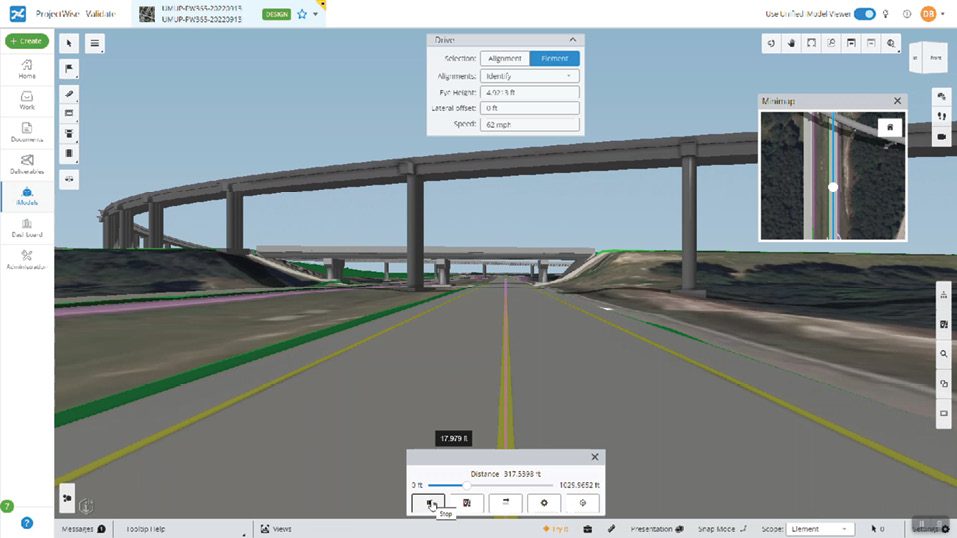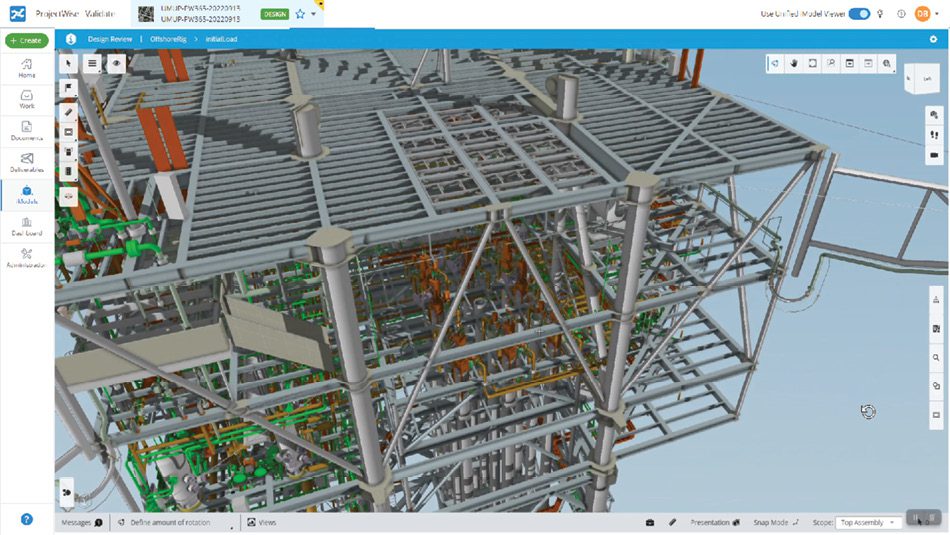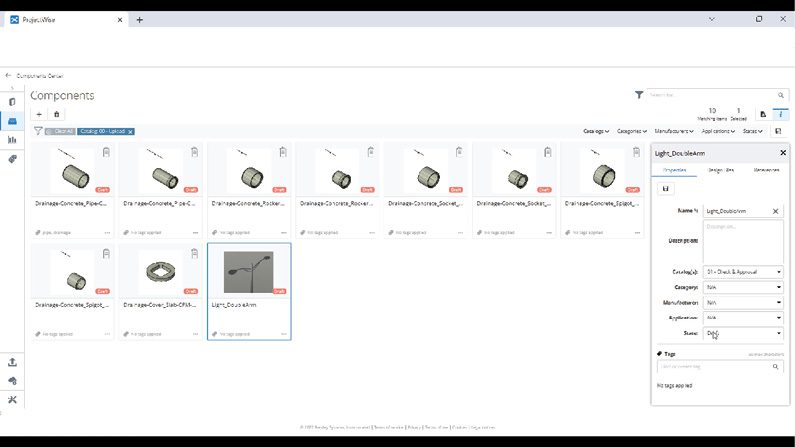Executive Interview Series: Keith Bentley CTO, Bentley Systems
In November 2022, Informed Infrastructure Editorial Director Todd Danielson went to Bentley Systems’ Year in Infrastructure and Going Digital Awards event in London where he interviewed Keith Bentley, a company founder and chief technology officer (CTO).
Since this interview, it was announced that Keith Bentley has stepped down as CTO to assume the role of technology advisor through his anticipated retirement later in 2023.
The full interview can be viewed above and at bit.ly/3kj9dGQ.
Danielson: Can you describe what it means to move from file-based to data-centric workflows?
Bentley: When you use files, they are the unit of locking, so you divide the world into small pieces so they can be changed independently. That works really well for designing, but if you are trying to convey information to somebody about the big picture, sending a series of files tends to cause disruption. What you would like to do is take all that information, combine it together, make it logically cohesive, make it queryable, make it so you can interrogate it. The iTwin philosophy is to take the information from the files, put it into a single database and make that database accessible everywhere. That is what our iTwin Platform is about.
Danielson: Can you describe how the iTwin Platform has evolved from the first official version in 2018 to now?
Bentley: The platform itself is different than when we first created it. It is open source, so we have had a lot of feedback from people who use it. It does the same things it did at the beginning, but we have extended it for different purposes, for example Internet of Things (IoT) devices. If you have a live accurate image or model of some infrastructure, connect it up to live sensors, it makes a lot of sense. We didn’t do that at the beginning.
Danielson: What is the importance of iTwin being an open platform?
Bentley: I think the success of digital twins in general relies on their information contained being accessible everywhere. The only way that is going to work long term is if the software itself is open source. That means people can use the software—the source code to the software—and create things without necessarily having to pay a fee. I think digital twins and openness are hand in hand. Given that, we decided to make our platform as open as we can, and that is what we have been working on.
Danielson: How more open can it get in the future?
Bentley: There are aspects of the platform that deal with specific types of data: integration with enterprise systems or reality capture. The techniques for doing that sometimes are proprietary and internal. We have tried to make it so you can combine it with closed systems, but we create the data in an open [environment]. It is really the interfaces that are open. I believe the software authors of digital twin solutions will contribute their code back to the community. We are already seeing that. They are making extensive use of the open source and making their own code open source as well. I think it is good for the community. I think it is good for the users. And I also think that it is good for the prospect that digital twins can become a real thing over time.

Bentley Systems

ProjectWise, powered by iTwin, supports full digital delivery, including simulating vehicle drive paths to ensure proper sightlines.
Danielson: In the keynote, you said engineers should be able to better reuse rich data from old projects into new projects to further industrialize design and construction. Can you elaborate on that?
Bentley: A perfect example is most projects today do not start from greenfields. At the beginning of Bentley Systems, a lot of projects were about creating new stuff. But more so all the time, it is about improving something that already exists or even demolishing something and replacing it. That happens all the time. To do that, you need the context of what was there, what is there, what should it be, what else have I done that looks like that. There are techniques now, because the information becomes accessible, that you can say, “Find me the closest match that will satisfy this set of problems, show me that as background information, maybe copy some of that data.” Instead of starting with a blank screen, you start with the history of everything you have done or potentially done. It is going to take some time before all the information gets into the [first] digital twin, [but] the next project starts from a digital twin.

Danielson: How will the iTwin experience help with data acquisition and asset maintenance?
Bentley: The concept of the iTwin experience is that there are a lot of data sources aggregated inside an iTwin, but they each have their own way of explaining what they mean and how they are created and who is allowed to access them. We tried to make the iTwin a way to unify common information. Then you drill down into types of information that is specific to a task or an individual or a project, and customize it. But in general, there are many things that are similar across projects, across disciplines within a project, and we tried to make that as accessible as we can.
Web-based experience is the norm nowadays for presenting information, but sometimes you’ll need to extract some subset of it onto your desktop, work for a time and post it back up into the iTwin experience. Hopefully, your user experience, no matter what tool you are using, is cohesive so you don’t end up with import/export problems that plague workflows today.

ProjectWise Components Center makes it easy to create component catalogs for your designs. (Bentley Systems)
Danielson: Do you expect iTwin IoT to be a boon to consultants providing data?
Bentley: I believe there is a market for people who are experts in dealing with information conveyed through sensors and control systems that—combined with engineering expertise—can create a new market for firms to become experts at being the systems integrator. If you are good at understanding the real-time aspect of a digital twin, I think it is going to be a unique skill. I believe there can be insights drawn from the data provided through IoT sensors that, otherwise, would not be possible. You can only find those trends by having that data.
Danielson: Can you talk a little bit about phase two of the iTwin model?
Bentley: The information that goes into digital twins has been somewhat disconnected from the actual digital twin, so there’s a conversion process. Engineering design tools create information in ways that automate the process of creating and managing data, but they don’t necessarily take into consideration all the other purposes that data could be used for. That connection from the design tool into the digital twin has been a job of someone outside the engineering profession. I think engineers should be connected to the digital twins, so that’s what we are talking about with “phase two.” One approach is to skip phase two and rewrite all the products that create data and make them natively edit digital twins. The problem with that is there are a lot of existing work processes built on top of current tools. So instead of doing that, we have decided to add digital twin capabilities to existing tools. I believe that is likely to be more successful than the “Big Bang theory” [because] people can incrementally adopt it. I think you should be able to decide to use a little bit of a digital twin on the first project, a little bit more on the next project. Before you know it, you will be a digital twin native.
Danielson: Which aspect of future technology you’re working on now are you most excited about?
Bentley: There are many areas where the philosophy of a digital twin can be more valuable than the philosophy of creating models for construction documentation. Ordinarily today, you model, you export into a format like an IFC or even to a PDF format. Often it is just a series of 2D documents. The handover steps should be continuous. You should not pick milestones and hand them only at those milestones. There are approval processes, but the incremental connection of the engineering process and the scheduling process and the construction process—tightening those loops, that has been a goal for many generations of software. But only in the digital twin world, I think, does it become not only possible but natural.
About Todd Danielson
Todd Danielson has been in trade technology media for more than 20 years, now the editorial director for V1 Media and all of its publications: Informed Infrastructure, Earth Imaging Journal, Sensors & Systems, Asian Surveying & Mapping, and the video news portal GeoSpatial Stream.


